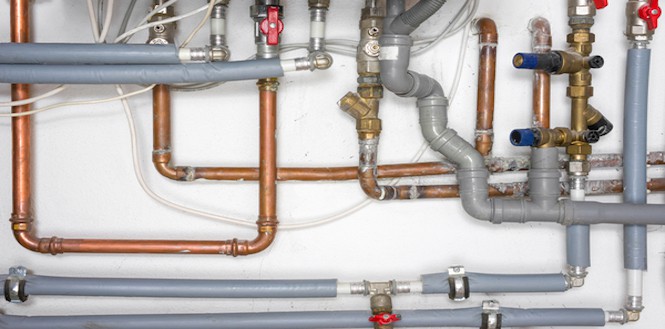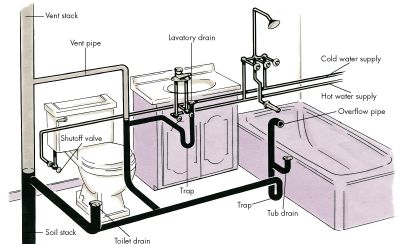Just how do you really feel about Anatomy of a House: Understanding the Components?

Understanding how your home's pipes system works is essential for every single homeowner. From providing clean water for drinking, cooking, and bathing to securely eliminating wastewater, a well-maintained pipes system is vital for your household's health and wellness and convenience. In this detailed overview, we'll check out the detailed network that comprises your home's plumbing and deal ideas on maintenance, upgrades, and managing common concerns.
Introduction
Your home's pipes system is more than just a network of pipelines; it's a complex system that ensures you have accessibility to clean water and reliable wastewater elimination. Knowing its parts and just how they work together can help you avoid pricey repairs and guarantee every little thing runs efficiently.
Basic Components of a Plumbing System
Pipelines and Tubes
At the heart of your pipes system are the pipes and tubing that lug water throughout your home. These can be made of numerous products such as copper, PVC, or PEX, each with its advantages in terms of longevity and cost-effectiveness.
Fixtures: Sinks, Toilets, Showers, etc.
Components like sinks, commodes, showers, and bathtubs are where water is used in your house. Comprehending just how these components connect to the plumbing system assists in detecting issues and intending upgrades.
Shutoffs and Shut-off Factors
Valves control the flow of water in your plumbing system. Shut-off valves are vital throughout emergency situations or when you require to make repair services, permitting you to separate parts of the system without interfering with water circulation to the whole residence.
Water Supply System
Main Water Line
The main water line links your home to the local supply of water or a personal well. It's where water enters your home and is dispersed to numerous components.
Water Meter and Pressure Regulator
The water meter actions your water use, while a stress regulator ensures that water flows at a safe pressure throughout your home's plumbing system, preventing damages to pipes and fixtures.
Cold Water vs. Hot Water Lines
Comprehending the distinction between cold water lines, which provide water directly from the primary, and warm water lines, which lug heated water from the water heater, aids in repairing and planning for upgrades.
Drainage System
Drain Pipes Piping and Traps
Drain pipes carry wastewater far from sinks, showers, and toilets to the sewer or septic system. Catches avoid sewage system gases from entering your home and likewise trap debris that could trigger clogs.
Ventilation Pipelines
Ventilation pipes enable air into the drain system, avoiding suction that might slow water drainage and trigger traps to vacant. Appropriate ventilation is necessary for maintaining the honesty of your pipes system.
Significance of Correct Drainage
Guaranteeing correct drain protects against backups and water damages. Regularly cleaning drains pipes and preserving catches can stop expensive repair services and prolong the life of your plumbing system.
Water Heater
Types of Hot Water Heater
Water heaters can be tankless or conventional tank-style. Tankless heating units heat water as needed, while storage tanks save heated water for instant usage.
Updating Your Pipes System
Factors for Upgrading
Updating to water-efficient components or changing old pipes can enhance water high quality, decrease water expenses, and increase the value of your home.
Modern Pipes Technologies and Their Advantages
Check out modern technologies like clever leak detectors, water-saving toilets, and energy-efficient water heaters that can conserve money and lower ecological influence.
Cost Factors To Consider and ROI
Calculate the ahead of time costs versus lasting savings when considering plumbing upgrades. Numerous upgrades spend for themselves via minimized energy expenses and less repair work.
Exactly How Water Heaters Link to the Pipes System
Recognizing just how hot water heater attach to both the cold water supply and warm water circulation lines helps in diagnosing issues like insufficient warm water or leakages.
Upkeep Tips for Water Heaters
Consistently purging your hot water heater to get rid of sediment, examining the temperature settings, and examining for leakages can expand its life-span and boost power efficiency.
Usual Pipes Concerns
Leaks and Their Causes
Leaks can take place as a result of maturing pipelines, loosened installations, or high water pressure. Addressing leakages immediately avoids water damage and mold development.
Blockages and Obstructions
Blockages in drains pipes and commodes are commonly brought on by flushing non-flushable items or a buildup of oil and hair. Utilizing drain displays and being mindful of what goes down your drains can protect against obstructions.
Indicators of Pipes Issues to Look For
Low water stress, sluggish drains, foul odors, or unusually high water costs are indicators of possible plumbing problems that need to be resolved without delay.
Pipes Upkeep Tips
Routine Evaluations and Checks
Set up annual pipes assessments to catch issues early. Seek indicators of leakages, rust, or mineral accumulation in faucets and showerheads.
DIY Upkeep Tasks
Basic tasks like cleansing tap aerators, looking for commode leakages utilizing dye tablet computers, or shielding subjected pipes in chilly environments can stop major pipes issues.
When to Call a Specialist Plumber
Know when a plumbing concern needs specialist competence. Attempting intricate repair work without appropriate expertise can lead to even more damage and greater repair service prices.
Tips for Decreasing Water Use
Easy routines like fixing leaks immediately, taking much shorter showers, and running full tons of laundry and recipes can conserve water and reduced your utility expenses.
Eco-Friendly Pipes Options
Think about lasting plumbing products like bamboo for floor covering, which is durable and eco-friendly, or recycled glass for kitchen counters.
Emergency situation Preparedness
Actions to Take During a Pipes Emergency situation
Know where your shut-off valves are located and exactly how to switch off the water supply in case of a burst pipeline or significant leak.
Significance of Having Emergency Calls Convenient
Keep contact info for neighborhood plumbings or emergency services conveniently offered for fast action throughout a plumbing dilemma.
Ecological Influence and Conservation
Water-Saving Fixtures and Home Appliances
Setting up low-flow taps, showerheads, and toilets can considerably decrease water use without giving up performance.
Do It Yourself Emergency Situation Fixes (When Applicable).
Short-term solutions like making use of duct tape to patch a leaking pipe or putting a pail under a trickling tap can lessen damages till a professional plumbing gets here.
Conclusion.
Comprehending the composition of your home's pipes system empowers you to maintain it effectively, saving time and money on repair work. By complying with routine upkeep regimens and remaining notified concerning modern-day pipes innovations, you can ensure your plumbing system runs efficiently for years to come.
HOW YOUR PLUMBING SYSTEM WORKS
Which Pipes Do What?
Blue lines = fresh water supply entering the building Red lines = hot water supply entering the building Grey lines = pipes carrying waste away from the building and venting pipes carrying gases away from the building (through the roof) YOUR MAIN PLUMBING SYSTEMS
There are two main plumbing systems that support your home s basic plumbing needs one that brings clean water into your home, and one that sends dirty water away from your home. Connected to the toilet, bath, shower, and other faucets in your home, these two systems keep your water flowing in the right directions.
ACCESSING FRESH WATER
Fresh and clean water is brought into your home through the main water supply line . Filtered through one pipe, this water is pressured to flow into the various fixtures in your home at any given time.
This water can be sourced from a well located on your property, a pond or river (mostly cottages), or, as in most cases, from the city s municipal water treatment centre. However, it is important to note that water that is untreated, such as the water siphoned from ponds or rivers, may not be safe to drink. Personal water supplies always need to be treated for hardness and contaminants before consumed.
MUNICIPAL WATER SUPPLIES
Improve taste and odour Remove sediment Eliminate hardness Reduce chlorine COLD WATER SUPPLY VS. HOT WATER SUPPLY
Cold water flows into your home or building through the service line, which then distributes hot or cold water to your fixtures. This line is most commonly run through a central column that runs floor to floor. Hot water runs in short and straight pipes as the longer the pipeline, the more heat that will be lost in the transfer. Having shorter pipes also allows residents to access hot water more quickly.
WASTE WATER SYSTEM
Your wastewater system is divided into two parts pipes that send wastewater away from your home and venting pipes that send sewer gas away from your home. Sewage water travels through pipes that flush the water and waste towards local sewers that are operated and managed by your city or town. Most sewer systems rely on gravity to move the wastewater to where it needs to go.
The further away from your toilet or sink, the larger wastewater pipes become. This allows for waste to be disposed of from various parts of your home or business at once without pipe blockages. The angle and flow of these pipes are also essential for keeping your waste pipes clear of build up.
https://harrisplumbing.ca/how-your-home-plumbing-system-works/

Hopefully you enjoyed reading our topic on Plumbing Installation 101: All You Need to Know. Thank you for finding the time to read our piece of content. Make sure you set aside a second to distribute this write-up if you appreciated it. Thanks so much for taking the time to read it.
Book Service Now